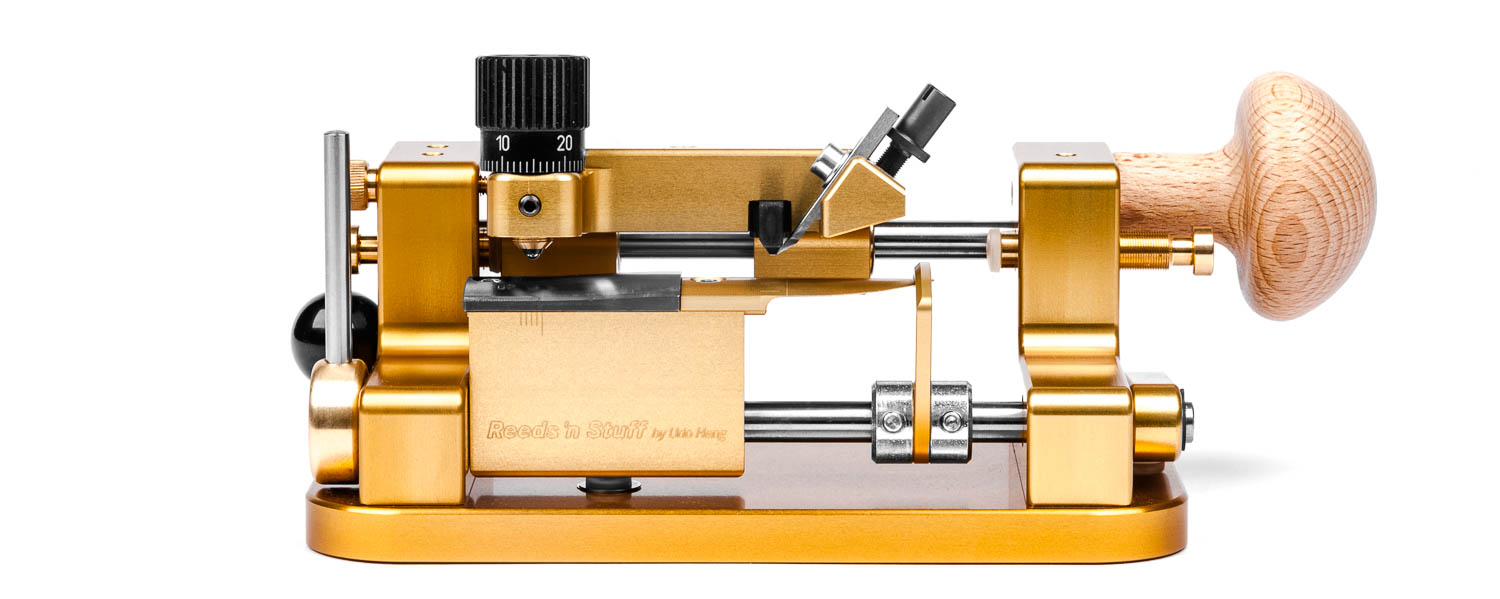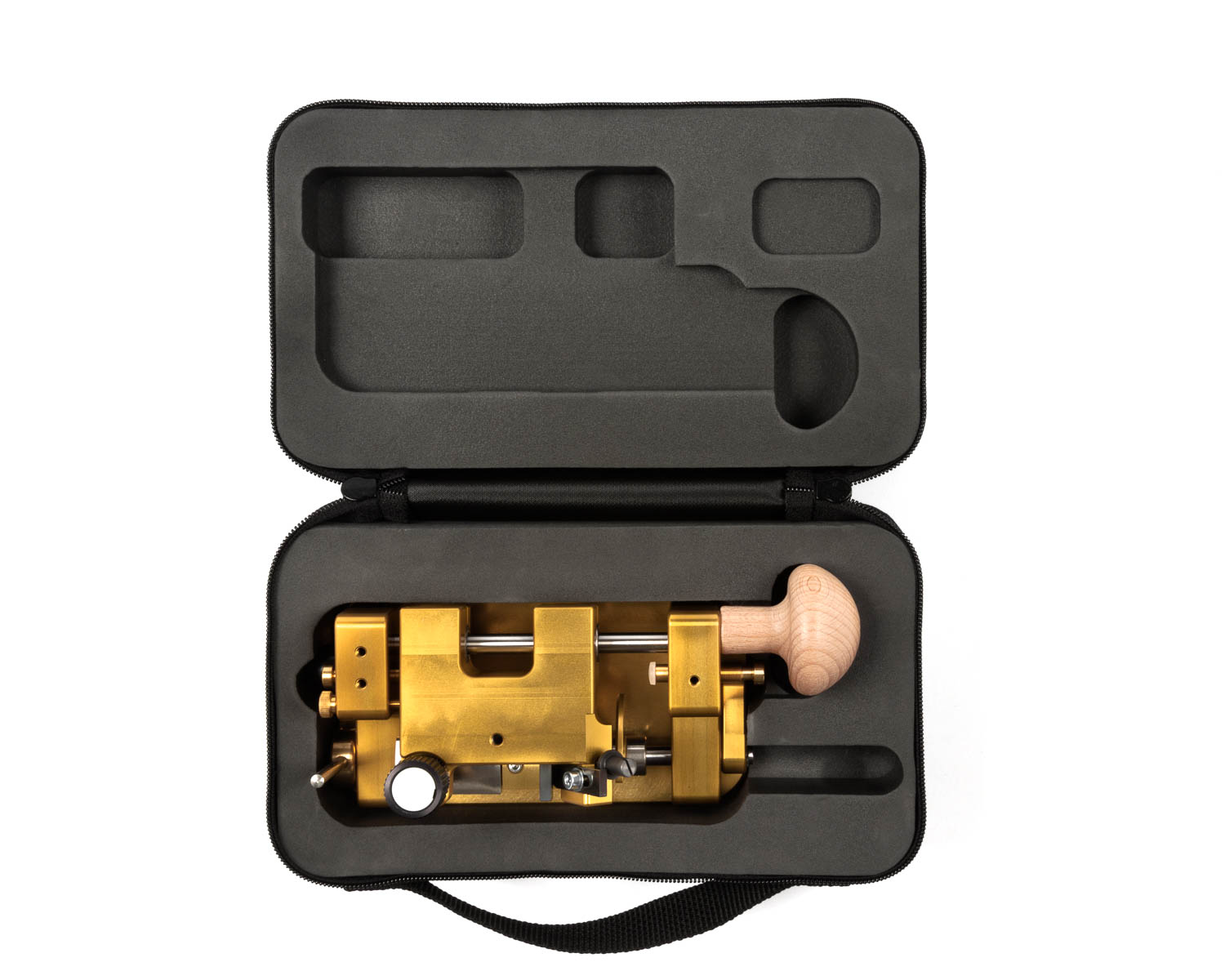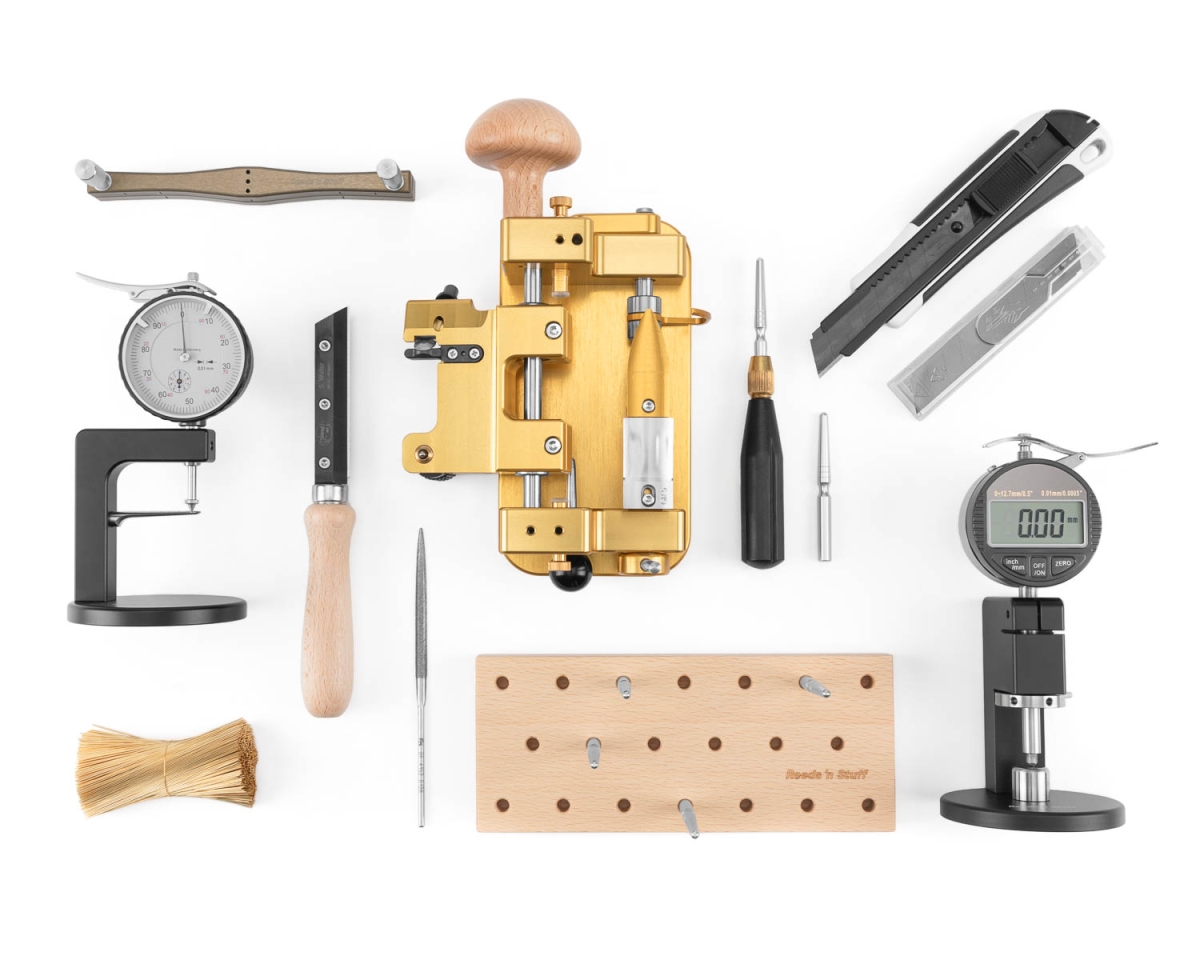Easy and Efficient
The tip profiling machine is the most efficient machine
for creating the profile in the front half of the reed.
This machine allows you to precisely produce a symmetrical and playable reed,
using our many available templates.
Built of high-quality anodized aluminum and a special german steel,
the tip profiling machine is built to last for many years.
Linear ball bearings provide a comfortable user experience.
Prepared for Transport

Prepare your tip profiler for transport.
Insert the mandrel into the designated hole on the left side, screw the wooden handle into the threaded hole on the right side, and lock the carriage into place with the transport locking screw on the left side of the machine.
Transport Bag Included

The Reeds 'n Stuff transport case features a simple design that's easy to use.
The foam interior allows for safe transport and provides a snug fit. The tools to adjust the machine can be stored in the zipper compartment on top of the case. The handle provides portability wherever you need it.
Test a Template
You can also test a template for 60 days.
- Weight
- 1440 g
Media
...
Sarah Warner Vik
Principal Bassoon of the Trondheim Symphony Orchestra
Matching Products
Yumi Deger
Bassoonist Yumi Deger (born Matsumoto) learned reed making at the age of 15 from her first teacher Masayuki Okamoto (Principal Bassoonist, Tokyo Metropolitan Symphony Orchestra and Professor, Tokyo University of Fine Arts). She has studied with Motoko Kawamura (Principal Bassoonist, New Japan Philharmonic Orchestra), Georg Klütsch (Professor, Hochschule für Musik und Tanz Köln), Valentino Zucchiatti (Principal Bassoonist, Teatro alla Scala), and Ulrich Hermann (Professor, Hochschule für Musik und Tanz Köln, previously Universität Mainz).
Through her skilfull selection of cane and fine reedwork she has become a sought-after reed maker among professors, soloists, orchestra musicians, and students. After many years of experience in the production of high-quality reeds, YUUMI REEDS has many high-profile regular customers in orchestras such as Gürzenich Orchester Köln, WDR Sinfonie Orchester, Tonhalle Zurich, Rotterdam Philharmonie Orchestra, and Theater Hannover.
Yumi Deger is popular as a substitute bassoonist in internationally renowned orchestras, teaches at several music schools (Musikschule der Stadt Düsseldorf, der Stadt Bonn, and der Stadt Köln), and is the bassoon reed making instructor at the Hochschule für Musik und Tanz Köln.
More InformationThe following collection of tools was put together with Yumi. They are the tools she herself uses to make reeds.
"The most important thing bassoonists should know about reed making is how to sort cane and which combination of brand, density, and hardness best suits them and their own bassoon."
Cane selection is of the utmost importance to Yumi's reed making process.
The first steps in her process are to split the tubes, soak them, cut them to length, and pregouge them. After letting the cane dry for several days Yumi will measure the cane for density and sort them into categories to become different types of reeds.
Based on the density and hardness Yumi will then gouge the cane to different thicknesses, to achieve the specific result she is aiming to get out of that particular piece of cane. During the gouging process she regularly measures the cane to ensure she achieves exactly the desired hardness and gouge thickness. This cane is then shaped on a R1A shape and profiled.
After scoring the tubes and folding the cane in half, Yumi will place the 0.6 mm brass wires. The blanks are left on the mandrel in a drying board until they are fully dried. Once the blanks are ready, and wrapped, she clips the blades to a length of 28 mm, then processes the blank with a GR5 template on the tip profiling machine.
After some careful adjustments with a file, 320-grit sandpaper, and a knife the reeds are sent out to the delight of bassoonists all over the world.
Reeds 'n Stuff regularly hosts reed making classes in conjunction with Yumi. If you want to learn the secrets to her cane sorting process and how she does the final reed adjustment, reach out to Yumi or be on the lookout for our next classes with her.
-

-
Reed Making Set YUMI
Buy
Recommended
Yumi Deger
Bassoonist Yumi Deger (born Matsumoto) learned reed making at the age of 15 from her first teacher Masayuki Okamoto (Principal Bassoonist, Tokyo Metropolitan Symphony Orchestra and Professor, Tokyo University of Fine Arts). She has studied with Motoko Kawamura (Principal Bassoonist, New Japan Philharmonic Orchestra), Georg Klütsch (Professor, Hochschule für Musik und Tanz Köln), Valentino Zucchiatti (Principal Bassoonist, Teatro alla Scala), and Ulrich Hermann (Professor, Hochschule für Musik und Tanz Köln, previously Universität Mainz).
Through her skilfull selection of cane and fine reedwork she has become a sought-after reed maker among professors, soloists, orchestra musicians, and students. After many years of experience in the production of high-quality reeds, YUUMI REEDS has many high-profile regular customers in orchestras such as Gürzenich Orchester Köln, WDR Sinfonie Orchester, Tonhalle Zurich, Rotterdam Philharmonie Orchestra, and Theater Hannover.
Yumi Deger is popular as a substitute bassoonist in internationally renowned orchestras, teaches at several music schools (Musikschule der Stadt Düsseldorf, der Stadt Bonn, and der Stadt Köln), and is the bassoon reed making instructor at the Hochschule für Musik und Tanz Köln.
More InformationThe following collection of tools was put together with Yumi. They are the tools she herself uses to make reeds.
"The most important thing bassoonists should know about reed making is how to sort cane and which combination of brand, density, and hardness best suits them and their own bassoon."
Cane selection is of the utmost importance to Yumi's reed making process.
The first steps in her process are to split the tubes, soak them, cut them to length, and pregouge them. After letting the cane dry for several days Yumi will measure the cane for density and sort them into categories to become different types of reeds.
Based on the density and hardness Yumi will then gouge the cane to different thicknesses, to achieve the specific result she is aiming to get out of that particular piece of cane. During the gouging process she regularly measures the cane to ensure she achieves exactly the desired hardness and gouge thickness. This cane is then shaped on a R1A shape and profiled.
After scoring the tubes and folding the cane in half, Yumi will place the 0.6 mm brass wires. The blanks are left on the mandrel in a drying board until they are fully dried. Once the blanks are ready, and wrapped, she clips the blades to a length of 28 mm, then processes the blank with a GR5 template on the tip profiling machine.
After some careful adjustments with a file, 320-grit sandpaper, and a knife the reeds are sent out to the delight of bassoonists all over the world.
Reeds 'n Stuff regularly hosts reed making classes in conjunction with Yumi. If you want to learn the secrets to her cane sorting process and how she does the final reed adjustment, reach out to Yumi or be on the lookout for our next classes with her.
-

-
Reed Making Set YUMI
Buy
